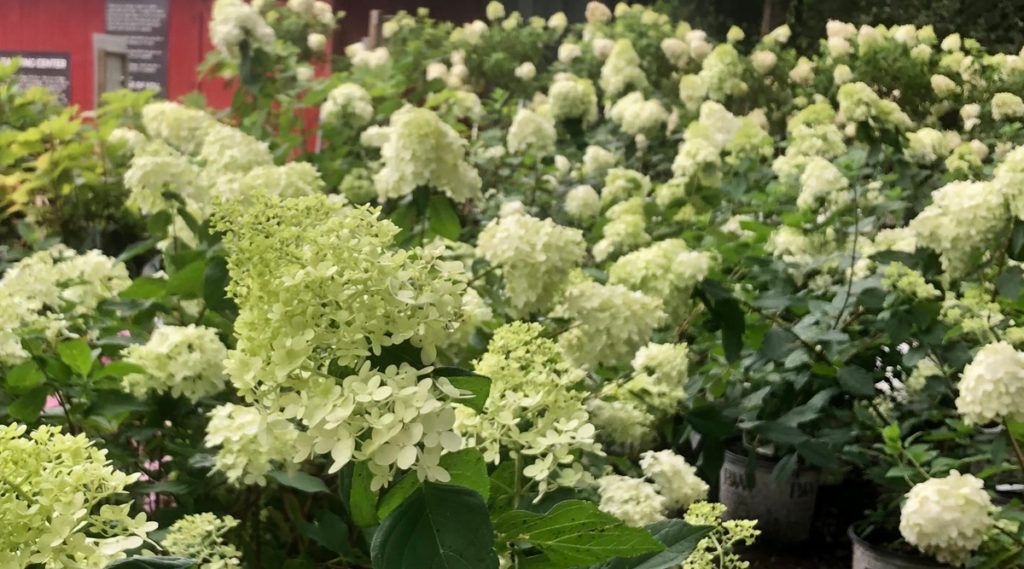Growing Limelight Hydrangeas in Arkansas
What is a paniculata hydrangea?
This post is really about growing tips for all panicle (Hydrangea paniculata) hydrangeas but we thought this title would catch your attention since Limelight is the most popular one right now! These hydrangeas have blooms in panicles, which means a branched indeterminate inflorescence, which forms a cone shaped flower head. The blooms are usually quite large, up to 15 inches in length, depending on variety.
When you think of hydrangeas, you might think of the traditional bigleaf hydrangea, the macrophylla species, which features large round inflorescence of blue, pink or white flowers. The paniculata species of hydrangea features bright lime or cream color blooms. The bloom color is not altered by soil pH, as in the macrophylla. Panicle hydrangeas blooms often fade to pink or even red, depending on variety. Another difference between the two species is the leaf shape; panicle hydrangeas have a smaller, more narrow leaf than macrophylla. For details on the different species of hydrangea, visit our All About Hydrangeas blog post.
We suggest planting hydrangea paniculata varieties in morning sun, with some protection from the sun during the heat of the day (more on this below). Hydrangeas like regular water and rich, well drained soil. If you aren’t sure how well your soil drains, check out this post for details on how to perform a drainage test.
Can they really take full Arkansas sun?
The biggest difference between all other hydrangeas and the paniculata species is sun tolerance. This specific species has identified as one that can take full sun. A hydrangea that can take full sun… what?! Is that even possible?! For Arkansas gardens, the answer is no and yes.
No, not when planted in heavy clay soil that holds water, with no amendments, in a hot space, such as against a wall, with sporadic water. We have a team member that has had outstanding success with his panicle hydrangea in full sun; this isn’t the experience of most of our customers. Here is why; when the plant stresses in full sun during mid-day hours June through mid-September, the stress symptom is a wilted appearance. When the plant is shaded again, the leaves perk up. However, in the meantime, most people panic and water it… usually too much and too often, especially if the soil doesn’t drain well. This then causes root rot and the plant fails to thrive.
Yes, panicle hydrangeas can take full sun when planted in an ideal growing environment, in rich soil that drains well, in a space that gets proper water, no more, no less. In areas with less intense summer sun, such as in the northern states (or even northern Arkansas), successfully growing this plant in full sun is easier. Most plants come pre-tagged from the grower; most of them have categorized panicle hydrangeas as full sun. At Good Earth, we place them with our part sun shrubs and have our Good Earth plant sign denote part sun in an effort to communicate where they will be most successful for the majority of landscapes in our area.
Remember our team member’s outstanding success? He assessed then properly amended his soil and provides the right amount of water; not too much or too little. We think of this plant similar to the way we think of a Japanese maple; can they grow in full Arkansas sun? Yes, it’s possible if the planting situation is just right, however, they will fare better with some protection from the afternoon sun.
Hydrangea trees are a thing?
Yup! The growth habit of paniculatas is also much more upright than some other species. Paniculatas are the only hydrangeas that can be pruned into a tree. This type of hydrangea blooms on new wood so it can be pruned after it blooms in the summer, during the winter or even in very early spring before it leafs out with no reduction of blooms; however, do not prune in the late spring or early summer as they are preparing to bloom.
‘Limelight’ and ‘Quickfire’ are two of the most popular panicle hydrangea trees on the market right now. ‘PeeGee’ used to be more popular but these newer varieties are more popular now because they have stronger stems that hold the blooms up better, although by the end of the season, the large blooms may still weigh down tree form plants. As of today (early July 2021) we have plenty of gorgeous ‘Limelight’ trees in stock, all in full, gorgeous bloom!
‘Limelight’ is a large growing variety (6- 8 feet tall and wide), and can be grown as either a tree or shrub. ‘Little Lime’ is very similar in look but grows to only 3- 6 feet in size and is grown as a shrub. We have plenty of both of these varieties in stock right now, and through the year, we have others as well. For more information about our current hydrangea selection, please visit this link.
